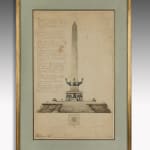Charles Heathcote Tatham (London, 1772-1842)
20 ½ x 12 ¾ in
The extensive inscription on the left-hand edge of this design reads:
‘This Design in the form of an Obelisk is 200 feet high; and is placed in the center of an artificial Rock serving as the mound or Basement, having a spacious Terrace all round for the spectators to view it with effect.'
'This mound or Basement is 30 ft high, & is ascended by a spacious flight of steps on the principal front which may be repeated on the other three sides if thought necessary, according to the local situation of the structure at the four angles of the Terrace on which the structure is immediately centred, are intended four pedestals with naval trophies, supporting each a large lion emblematic of British Generosity and Valour.'
'On the principal front of the Grand Basement represented first in a prominent attitude the statue of his present Majesty in the Center elevated on a pedestal with a suitable inscription of gratitude to Divine Providence, against which are affixed medallions of the Rt. Hon. Mr Pitt & Earl Spencer.'
'On each side of the statue is a figure of Fame in ???so where, with the arms extended in a grand posture holding medallions of the gallant admirals Howe, St Vincent, Duncan, Nelson. Each figure stands on a globe in allusion to its fame &influence over the Universe.'
'The back front of the Grand Base is supposed to be appropriated for Tablets of Inscriptions allusions to the 4 great Victories.'
'The sides are appropriated to Tablets of future achievements.'
'At the foot of the obelisk are represented on the several sides prows of modern ships decorated with Victories in bronze.'
'All the decorations are of bronze.’
Charles Heathcote Tatham (1772-1842): was born in Westminster. At the age of 16, he began his career as clerk to the architect and surveyor Samuel Pepys Cockerell (1753-1827), before training under Henry Holland (1745-1806), architect to the Prince of Wales. Whilst at Holland’s office, Tatham contributed to the designs for Carlton House, Pall Mall and Woburn Abbey in Bedfordshire, as well as designing the ornamental decorations for the royal boxes at the Theatre Royal, Drury Lane.
Charles Heathcote Tatham’s design work was inspired by classical Roman architecture. Holland encouraged him to study and collect antique fragments and sculpture in Italy. Tatham travelled to Rome in July 1794 with the architect and painter Joseph Gandy (1771-1843), and stayed there for two years in order to gather material – producing drawings and sketches and buying antique fragments for Holland. He used these drawings to inspire his design work and produced 1799 publication: ‘Etchings, Representing the Best Examples of Ancient Ornamental Architecture; Drawn from the Originals in Rome and other parts of Italy, during the years 1794, 1795 and 1796, 1799’.
On 15th August 1799, a proposal was put forward to build a National Naval Monument to commemorate the British naval victories and heroes of the French Wars. The Treasury issued an invitation and ‘artists of every description [were] hereby solicited to offer Designs for this purpose’. Tatham submitted three designs. A variety of schemes were put forward, from simple columns to statues, vast monuments and mausolea, and a variety of locations suggested. There was much disagreement over what form the monument should take and where it should be situated; and this, in addition to insufficient funds and the collapse of Pitt’s government in 1801, resulted in the scheme being shelved, and the monies raised being returned. Having heard nothing by 1802, Tatham published his three designs, dedicating them to the Earl of Carlisle, for whom he had designed interiors at Castle Howard. The present drawing is the most finished of his designs, a combination of the two other published ideas. Six other designs for the scheme, not related to the engraved versions, are in the Yale Center for British Art, New Haven. The idea was re-visited on various occasions including in 1815, when Parliament voted funds for the completion of a ‘Naval Pillar’ to commemorate the victories in the recently ended French Wars'. Finally, in February 1838, space was made available outside the National Gallery, London, which led to Nelson’s Column, as designed by William Railton (1800-1877), being completed in 1843.




